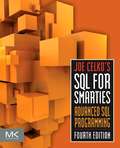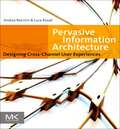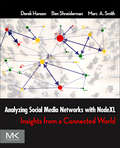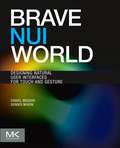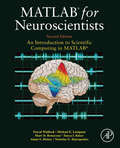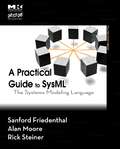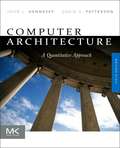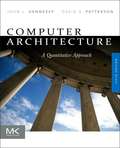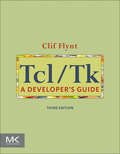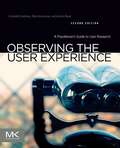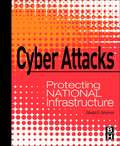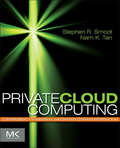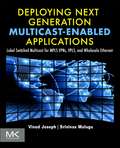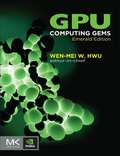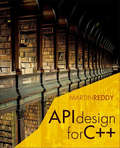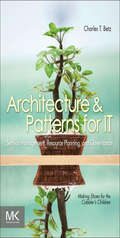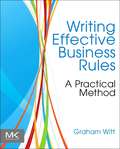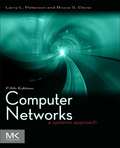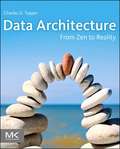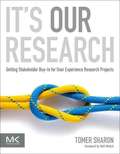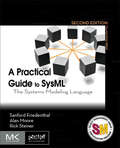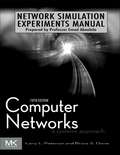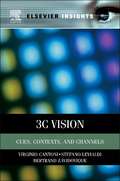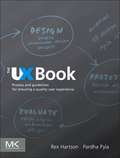- Table View
- List View
Joe Celko's SQL for Smarties: Advanced SQL Programming (The Morgan Kaufmann Series in Data Management Systems)
by Joe CelkoJoe Celkos SQL for Smarties: Advanced SQL Programming offers tips and techniques in advanced programming. This book is the fourth edition and it consists of 39 chapters, starting with a comparison between databases and file systems. It covers transactions and currency control, schema level objects, locating data and schema numbers, base tables, and auxiliary tables. Furthermore, procedural, semi-procedural, and declarative programming are explored in this book. The book also presents the different normal forms in database normalization, including the first, second, third, fourth, fifth, elementary key, domain-key, and Boyce-Codd normal forms. It also offers practical hints for normalization and denormalization. The book discusses different data types, such as the numeric, temporal and character data types; the different predicates; and the simple and advanced SELECT statements. In addition, the book presents virtual tables, and it discusses data partitions in queries; grouping operations; simple aggregate functions; and descriptive statistics, matrices and graphs in SQL. The book concludes with a discussion about optimizing SQL. It will be of great value to SQL programmers. Expert advice from a noted SQL authority and award-winning columnist who has given ten years service to the ANSI SQL standards committeeTeaches scores of advanced techniques that can be used with any product, in any SQL environment, whether it is an SQL 92 or SQL 2008 environmentOffers tips for working around deficiencies and gives insight into real-world challenges
Electronic Access Control
by Thomas L. NormanElectronic Access Control introduces the fundamentals of electronic access control through clear, well-illustrated explanations. Access Control Systems are difficult to learn and even harder to master due to the different ways in which manufacturers approach the subject and the myriad complications associated with doors, door frames, hardware, and electrified locks. This book consolidates this information, covering a comprehensive yet easy-to-read list of subjects that every Access Control System Designer, Installer, Maintenance Tech or Project Manager needs to know in order to develop quality and profitable Alarm/Access Control System installations. Within these pages, Thomas L. Norman – a master at electronic security and risk management consulting and author of the industry reference manual for the design of Integrated Security Systems – describes the full range of EAC devices (credentials, readers, locks, sensors, wiring, and computers), showing how they work, and how they are installed.A comprehensive introduction to all aspects of electronic access control Provides information in short bursts with ample illustrations Each chapter begins with outline of chapter contents and ends with a quiz May be used for self-study, or as a professional reference guide
Pervasive Information Architecture: Designing Cross-Channel User Experiences
by Andrea Resmini Luca RosatiPervasive Information Architecture explains the ‘why’ and ‘how’ of pervasive information architecture (IA) through detailed examples and real-world stories. It offers insights about trade-offs that can be made and techniques for even the most unique design challenges. The book will help readers master agile information structures while meeting their unique needs on such devices as smart phones, GPS systems, and tablets. The book provides examples showing how to: model and shape information to adapt itself to users’ needs, goals, and seeking strategies; reduce disorientation and increase legibility and way-finding in digital and physical spaces; and alleviate the frustration associated with choosing from an ever-growing set of information, services, and goods. It also describes relevant connections between pieces of information, services and goods to help users achieve their goals. This book will be of value to practitioners, researchers, academics, andstudents in user experience design, usability, information architecture, interaction design, HCI, web interaction/interface designer, mobile application design/development, and information design. Architects and industrial designers moving into the digital realm will also find this book helpful.Master agile information structures while meeting the unique user needs on such devices as smart phones, GPS systems, and tabletsFind out the ‘why’ and ‘how’ of pervasive information architecture (IA) through detailed examples and real-world storiesLearn about trade-offs that can be made and techniques for even the most unique design challenges
Analyzing Social Media Networks with NodeXL: Insights from a Connected World
by Ben Shneiderman Derek Hansen Marc A. SmithAnalyzing Social Media Networks with NodeXL offers backgrounds in information studies, computer science, and sociology. This book is divided into three parts: analyzing social media, NodeXL tutorial, and social-media network analysis case studies. Part I provides background in the history and concepts of social media and social networks. Also included here is social network analysis, which flows from measuring, to mapping, and modeling collections of connections. The next part focuses on the detailed operation of the free and open-source NodeXL extension of Microsoft Excel, which is used in all exercises throughout this book. In the final part, each chapter presents one form of social media, such as e-mail, Twitter, Facebook, Flickr, and Youtube. In addition, there are descriptions of each system, the nature of networks when people interact, and types of analysis for identifying people, documents, groups, and events. Walks you through NodeXL, while explaining the theory and development behind each step, providing takeaways that can apply to any SNADemonstrates how visual analytics research can be applied to SNA tools for the mass marketIncludes case studies from researchers who use NodeXL on popular networks like email, Facebook, Twitter, and wikisDownload companion materials and resources at https://nodexl.codeplex.com/documentation
Brave NUI World: Designing Natural User Interfaces for Touch and Gesture
by Daniel Wigdor Dennis WixonBrave NUI World is the first practical guide for designing touch- and gesture-based user interfaces. Written by the team from Microsoft that developed the multi-touch, multi-user Surface® tabletop product, it introduces the reader to natural user interfaces (NUI). It gives readers the necessary tools and information to integrate touch and gesture practices into daily work, presenting scenarios, problem solving, metaphors, and techniques intended to avoid making mistakes. This book considers diverse user needs and context, real world successes and failures, and the future of NUI. It presents thirty scenarios, giving practitioners a multitude of considerations for making informed design decisions and helping to ensure that missteps are never made again. The book will be of value to game designers as well as practitioners, researchers, and students interested in learning about user experience design, user interface design, interaction design, software design, human computer interaction, human factors, information design, and information architecture. Provides easy-to-apply design guidance for the unique challenge of creating touch- and gesture-based user interfacesConsiders diverse user needs and context, real world successes and failures, and a look into the future of NUIPresents thirty scenarios, giving practitioners a multitude of considerations for making informed design decisions and helping to ensure that missteps are never made again
MATLAB for Neuroscientists: An Introduction to Scientific Computing in MATLAB
by Pascal Wallisch Michael E. Lusignan Marc D. Benayoun Tanya I. Baker Adam Seth Dickey Nicholas G. HatsopoulosMATLAB for Neuroscientists serves as the only complete study manual and teaching resource for MATLAB, the globally accepted standard for scientific computing, in the neurosciences and psychology. This unique introduction can be used to learn the entire empirical and experimental process (including stimulus generation, experimental control, data collection, data analysis, modeling, and more), and the 2nd Edition continues to ensure that a wide variety of computational problems can be addressed in a single programming environment. This updated edition features additional material on the creation of visual stimuli, advanced psychophysics, analysis of LFP data, choice probabilities, synchrony, and advanced spectral analysis. Users at a variety of levels—advanced undergraduates, beginning graduate students, and researchers looking to modernize their skills—will learn to design and implement their own analytical tools, and gain the fluency required to meet the computational needs of neuroscience practitioners. The first complete volume on MATLAB focusing on neuroscience and psychology applicationsProblem-based approach with many examples from neuroscience and cognitive psychology using real dataIllustrated in full color throughout Careful tutorial approach, by authors who are award-winning educators with strong teaching experience
A Practical Guide to SysML: The Systems Modeling Language (The MK/OMG Press)
by Rick Steiner Alan Moore Sanford FriedenthalA Practical Guide to SysML: The Systems Modeling Language is a comprehensive guide to SysML for systems and software engineers. It provides an advanced and practical resource for modeling systems with SysML. The source describes the modeling language and offers information about employing SysML in transitioning an organization or project to model-based systems engineering. The book also presents various examples to help readers understand the OMG Systems Modeling Professional (OCSMP) Certification Program. The text is organized into four parts. The first part provides an overview of systems engineering. It explains the model-based approach by comparing it with the document-based approach and providing the modeling principles. The overview of SYsML is also discussed. The second part of the book covers a comprehensive description of the language. It discusses the main concepts of model organization, parametrics, blocks, use cases, interactions, requirements, allocations, and profiles. The third part presents examples that illustrate how SysML supports different model-based procedures. The last part discusses how to transition and deploy SysML into an organization or project. It explains the integration of SysML into a systems development environment. Furthermore, it describes the category of data that are exchanged between a SysML tool and other types of tools, and the types of exchange mechanisms that can be used. It also covers the criteria that must be considered when selecting a SysML. Software and systems engineers, programmers, IT practitioners, experts, and non-experts will find this book useful.*The authoritative guide for understanding and applying SysML*Authored by the foremost experts on the language*Language description, examples, and quick reference guide included
Computer Architecture: A Quantitative Approach (The\morgan Kaufmann Series In Computer Architecture And Design Series (PDF))
by John L. Hennessy David A. PattersonComputer Architecture: A Quantitative Approach, Fifth Edition, explores the ways that software and technology in the cloud are accessed by digital media, such as cell phones, computers, tablets, and other mobile devices. The book, which became a part of Intel's 2012 recommended reading list for developers, covers the revolution of mobile computing. It also highlights the two most important factors in architecture today: parallelism and memory hierarchy. This fully updated edition is comprised of six chapters that follow a consistent framework: explanation of the ideas in each chapter; a crosscutting issues section, which presents how the concepts covered in one chapter connect with those given in other chapters; a putting it all together section that links these concepts by discussing how they are applied in real machine; and detailed examples of misunderstandings and architectural traps commonly encountered by developers and architects. Formulas for energy, static and dynamic power, integrated circuit costs, reliability, and availability are included. The book also covers virtual machines, SRAM and DRAM technologies, and new material on Flash memory. Other topics include the exploitation of instruction-level parallelism in high-performance processors, superscalar execution, dynamic scheduling and multithreading, vector architectures, multicore processors, and warehouse-scale computers (WSCs). There are updated case studies and completely new exercises. Additional reference appendices are available online. This book will be a valuable reference for computer architects, programmers, application developers, compiler and system software developers, computer system designers and application developers. Part of Intel's 2012 Recommended Reading List for Developers Updated to cover the mobile computing revolution Emphasizes the two most important topics in architecture today: memory hierarchy and parallelism in all its forms. Develops common themes throughout each chapter: power, performance, cost, dependability, protection, programming models, and emerging trends ("What's Next") Includes three review appendices in the printed text. Additional reference appendices are available online. Includes updated Case Studies and completely new exercises.
Computer Architecture: A Quantitative Approach (ISSN)
by David A. Patterson John L. HennessyComputer Architecture: A Quantitative Approach, Fifth Edition, explores the ways that software and technology in the cloud are accessed by digital media, such as cell phones, computers, tablets, and other mobile devices. The book, which became a part of Intel's 2012 recommended reading list for developers, covers the revolution of mobile computing. It also highlights the two most important factors in architecture today: parallelism and memory hierarchy. This fully updated edition is comprised of six chapters that follow a consistent framework: explanation of the ideas in each chapter; a crosscutting issues section, which presents how the concepts covered in one chapter connect with those given in other chapters; a putting it all together section that links these concepts by discussing how they are applied in real machine; and detailed examples of misunderstandings and architectural traps commonly encountered by developers and architects. Formulas for energy, static and dynamic power, integrated circuit costs, reliability, and availability are included. The book also covers virtual machines, SRAM and DRAM technologies, and new material on Flash memory. Other topics include the exploitation of instruction-level parallelism in high-performance processors, superscalar execution, dynamic scheduling and multithreading, vector architectures, multicore processors, and warehouse-scale computers (WSCs). There are updated case studies and completely new exercises. Additional reference appendices are available online. This book will be a valuable reference for computer architects, programmers, application developers, compiler and system software developers, computer system designers and application developers. Part of Intel's 2012 Recommended Reading List for DevelopersUpdated to cover the mobile computing revolutionEmphasizes the two most important topics in architecture today: memory hierarchy and parallelism in all its forms.Develops common themes throughout each chapter: power, performance, cost, dependability, protection, programming models, and emerging trends ("What's Next")Includes three review appendices in the printed text. Additional reference appendices are available online.Includes updated Case Studies and completely new exercises.
Tcl/Tk: A Developer's Guide (The Morgan Kaufmann Series in Software Engineering and Programming)
by Clif FlyntNewly updated with over 150 pages of material on the latest Tcl extensions, Tcl/Tk: A Developer’s Guide is a unique practical tutorial for professional programmers and beginners alike. Starting with a clear picture of the basics, Tcl/Tk covers the variety of tools in this "Swiss army knife" of programming languages, giving you the ability to enhance your programs, extend your application's capabilities, and become a more effective programmer. This updated edition covers all of the new features of version 8.6, including object-oriented programming and the creation of megawidgets, existing data structure implementations, themed widgets and virtual events. Extensive code snippets and online tutorials in various languages will give you a firm grasp on how to use the Tcl/Tk libraries and interpreters and, most importantly, on what constitutes an effective strategy for using Tcl/Tk. Includes the latest features of Tcl/Tk 8.6Covers Tcl development tools, popular extensions, and packages to allow developers to solve real-world problems with Tcl/Tk immediatelyProvides straightforward explanations for beginners and offers tips, style guidelines, and debugging techniques for advanced users
Observing the User Experience: A Practitioner's Guide to User Research (Morgan Kaufmann Series In Interactive Technologies)
by Elizabeth Goodman Mike Kuniavsky Andrea MoedObserving the User Experience: A Practitioner’s Guide to User Research aims to bridge the gap between what digital companies think they know about their users and the actual user experience. Individuals engaged in digital product and service development often fail to conduct user research. The book presents concepts and techniques to provide an understanding of how people experience products and services. The techniques are drawn from the worlds of human-computer interaction, marketing, and social sciences. The book is organized into three parts. Part I discusses the benefits of end-user research and the ways it fits into the development of useful, desirable, and successful products. Part II presents techniques for understanding people’s needs, desires, and abilities. Part III explains the communication and application of research results. It suggests ways to sell companies and explains how user-centered design can make companies more efficient and profitable. This book is meant for people involved with their products’ user experience, including program managers, designers, marketing managers, information architects, programmers, consultants, and investors. Explains how to create usable products that are still original, creative, and uniqueA valuable resource for designers, developers, project managers - anyone in a position where their work comes in direct contact with the end userProvides a real-world perspective on research and provides advice about how user research can be done cheaply, quickly and how results can be presented persuasivelyGives readers the tools and confidence to perform user research on their own designs and tune their software user experience to the unique needs of their product and its users
Cyber Attacks: Protecting National Infrastructure
by Edward AmorosoCyber Attacks takes the national debate on protecting critical infrastructure in an entirely new and fruitful direction. It initiates an intelligent national (and international) dialogue amongst the general technical community around proper methods for reducing national risk. This includes controversial themes such as the deliberate use of deception to trap intruders. It also serves as an attractive framework for a new national strategy for cyber security, something that several Presidential administrations have failed in attempting to create. In addition, nations other than the US might choose to adopt the framework as well. This book covers cyber security policy development for massively complex infrastructure using ten principles derived from experiences in U.S. Federal Government settings and a range of global commercial environments. It provides a unique and provocative philosophy of cyber security that directly contradicts conventional wisdom about info sec for small or enterprise-level systems. It illustrates the use of practical, trial-and-error findings derived from 25 years of hands-on experience protecting critical infrastructure on a daily basis at AT&T. Each principle is presented as a separate security strategy, along with pages of compelling examples that demonstrate use of the principle. Cyber Attacks will be of interest to security professionals tasked with protection of critical infrastructure and with cyber security; CSOs and other top managers; government and military security specialists and policymakers; security managers; and students in cybersecurity and international security programs.* Covers cyber security policy development for massively complex infrastructure using ten principles derived from experiences in U.S. Federal Government settings and a range of global commercial environments. * Provides a unique and provocative philosophy of cyber security that directly contradicts conventional wisdom about info sec for small or enterprise-level systems. * Illustrates the use of practical, trial-and-error findings derived from 25 years of hands-on experience protecting critical infrastructure on a daily basis at AT&T.
Private Cloud Computing: Consolidation, Virtualization, and Service-Oriented Infrastructure
by Stephen R Smoot Nam K TanPrivate cloud computing enables you to consolidate diverse enterprise systems into one that is cloud-based and can be accessed by end-users seamlessly, regardless of their location or changes in overall demand. Expert authors Steve Smoot and Nam K. Tan distill their years of networking experience to describe how to build enterprise networks to create a private cloud. With their techniques you'll create cost-saving designs and increase the flexibility of your enterprise, while maintaining the security and control of an internal network. Private Cloud Computing offers a complete cloud architecture for enterprise networking by synthesizing WAN optimization, next-generation data centers, and virtualization in a network-friendly way, tying them together into a complete solution that can be progressively migrated to as time and resources permit.Describes next-generation data center architectures such as the virtual access-layer, the unified data center fabric and the "rack-and-roll" deployment modelProvides an overview of cloud security and cloud management from the server virtualization perspectivePresents real-world case studies, configuration and examples that allow you to easily apply practical know-how to your existing enterprise environmentOffers effective private cloud computing solutions to simplify the costly and problematic challenge of enterprise networking and branch server consolidation
Deploying Next Generation Multicast-enabled Applications: Label Switched Multicast for MPLS VPNs, VPLS, and Wholesale Ethernet
by Vinod Joseph Srinivas MuluguDeploying Next Generation Multicast-Enabled Applications: Label Switched Multicast for MPLS VPNs, VPLS, and Wholesale Ethernet provides a comprehensive discussion of Multicast and MVPN standards—next-generation Multicast-based standards, Multicast Applications, and case studies with detailed configurations. Focusing on three vendors—Juniper, Cisco, and Alcatel-Lucent—the text features illustrations that contain configurations of JUNOS, TiMOS (Alcatel’s OS), or Cisco IOS, and each configuration is explained in great detail. Multiple- rather than single-vendor configurations were selected for the sake of diversity as well as to highlight the direction in which the overall industry is going rather than that of a specific vendor. Beginning with a discussion of the building blocks or basics of IP Multicast, the book then details applications and emerging trends, including vendor adoptions, as well as the future of Multicast. The book is written for engineers, technical managers, and visionaries engaged in the development of next-generation IP Multicast infrastructures.Offers contextualized case studies for illustrating deployment of the Next Generation Multicast technology Provides the background necessary to understand current generation multi-play applications and their service requirements Includes practical tips on various migration options available for moving to the Next Generation framework from the legacy
GPU Computing Gems Emerald Edition (Applications of GPU Computing Series)
by Wen-mei W. HwuGPU Computing Gems Emerald Edition offers practical techniques in parallel computing using graphics processing units (GPUs) to enhance scientific research. The first volume in Morgan Kaufmann's Applications of GPU Computing Series, this book offers the latest insights and research in computer vision, electronic design automation, and emerging data-intensive applications. It also covers life sciences, medical imaging, ray tracing and rendering, scientific simulation, signal and audio processing, statistical modeling, video and image processing. This book is intended to help those who are facing the challenge of programming systems to effectively use GPUs to achieve efficiency and performance goals. It offers developers a window into diverse application areas, and the opportunity to gain insights from others' algorithm work that they may apply to their own projects. Readers will learn from the leading researchers in parallel programming, who have gathered their solutions and experience in one volume under the guidance of expert area editors. Each chapter is written to be accessible to researchers from other domains, allowing knowledge to cross-pollinate across the GPU spectrum. Many examples leverage NVIDIA's CUDA parallel computing architecture, the most widely-adopted massively parallel programming solution. The insights and ideas as well as practical hands-on skills in the book can be immediately put to use. Computer programmers, software engineers, hardware engineers, and computer science students will find this volume a helpful resource. For useful source codes discussed throughout the book, the editors invite readers to the following website: …"Covers the breadth of industry from scientific simulation and electronic design automation to audio / video processing, medical imaging, computer vision, and moreMany examples leverage NVIDIA's CUDA parallel computing architecture, the most widely-adopted massively parallel programming solutionOffers insights and ideas as well as practical "hands-on" skills you can immediately put to use
API Design for C++
by Martin ReddyAPI Design for C++ provides a comprehensive discussion of Application Programming Interface (API) development, from initial design through implementation, testing, documentation, release, versioning, maintenance, and deprecation. It is the only book that teaches the strategies of C++ API development, including interface design, versioning, scripting, and plug-in extensibility. Drawing from the author's experience on large scale, collaborative software projects, the text offers practical techniques of API design that produce robust code for the long term. It presents patterns and practices that provide real value to individual developers as well as organizations. API Design for C++ explores often overlooked issues, both technical and non-technical, contributing to successful design decisions that product high quality, robust, and long-lived APIs. It focuses on various API styles and patterns that will allow you to produce elegant and durable libraries. A discussion on testing strategies concentrates on automated API testing techniques rather than attempting to include end-user application testing techniques such as GUI testing, system testing, or manual testing. Each concept is illustrated with extensive C++ code examples, and fully functional examples and working source code for experimentation are available online. This book will be helpful to new programmers who understand the fundamentals of C++ and who want to advance their design skills, as well as to senior engineers and software architects seeking to gain new expertise to complement their existing talents. Three specific groups of readers are targeted: practicing software engineers and architects, technical managers, and students and educators. The only book that teaches the strategies of C++ API development, including design, versioning, documentation, testing, scripting, and extensibility. Extensive code examples illustrate each concept, with fully functional examples and working source code for experimentation available online.Covers various API styles and patterns with a focus on practical and efficient designs for large-scale long-term projects.
Architecture and Patterns for IT Service Management, Resource Planning, and Governance: Making Shoes for the Cobbler's Children
by Charles T. BetzInformation technology supports efficient operations, enterprise integration, and seamless value delivery, yet itself is too often inefficient, un-integrated, and of unclear value. This completely rewritten version of the bestselling Architecture and Patterns for IT Service Management, Resource Planning and Governance retains the original (and still unique) approach: apply the discipline of enterprise architecture to the business of large scale IT management itself. Author Charles Betz applies his deep practitioner experience to a critical reading of ITIL 2011, COBIT version 4, the CMMI suite, the IT portfolio management literature, and the Agile/Lean IT convergence, and derives a value stream analysis, IT semantic model, and enabling systems architecture (covering current topics such as CMDB/CMS, Service Catalog, and IT Portfolio Management). Using the concept of design patterns, the book then presents dozens of visual models documenting challenging problems in integrating IT management, showing how process, data, and IT management systems must work together to enable IT and its business partners. The edition retains the fundamental discipline of traceable process, data, and system analysis that has made the first edition a favored desk reference for IT process analysts around the world. This best seller is a must read for anyone charged with enterprise architecture, IT planning, or IT governance and management.Lean-oriented process analysis of IT management, carefully distinguished from an IT functional modelField-tested conceptual information model with definitions and usage scenarios, mapped to both the process and system architecturesIntegrated architecture for IT management systemsSynthesizes Enterprise Architecture, IT Service Management, and IT Portfolio Management in a practical way
Writing Effective Business Rules
by Graham WittWriting Effective Business Rules moves beyond the fundamental dilemma of system design: defining business rules either in natural language, intelligible but often ambiguous, or program code (or rule engine instructions), unambiguous but unintelligible to stakeholders. Designed to meet the needs of business analysts, this book provides an exhaustive analysis of rule types and a set of syntactic templates from which unambiguous natural language rule statements of each type can be generated. A user guide to the SBVR specification, it explains how to develop an appropriate business vocabulary and generate quality rule statements using the appropriate templates and terms from the vocabulary. The resulting rule statements can be reviewed by business stakeholders for relevance and correctness, providing for a high level of confidence in their successful implementation.A complete set of standard templates for rule statements and their component syntactic elementsA rigorous approach to rule statement construction to avoid ambiguity and ensure consistencyA clear explanation of the way in which a fact model provides and constrains the rule statement vocabularyA practical reader-friendly user guide to the those parts of the SBVR specification that are relevant to rule authoring
Computer Networks: A Systems Approach (ISSN)
by Larry L. Peterson Bruce S. DavieComputer Networks: A Systems Approach, Fifth Edition, explores the key principles of computer networking, with examples drawn from the real world of network and protocol design. Using the Internet as the primary example, this best-selling and classic textbook explains various protocols and networking technologies. The systems-oriented approach encourages students to think about how individual network components fit into a larger, complex system of interactions. This book has a completely updated content with expanded coverage of the topics of utmost importance to networking professionals and students, including P2P, wireless, network security, and network applications such as e-mail and the Web, IP telephony and video streaming, and peer-to-peer file sharing. There is now increased focus on application layer issues where innovative and exciting research and design is currently the center of attention. Other topics include network design and architecture; the ways users can connect to a network; the concepts of switching, routing, and internetworking; end-to-end protocols; congestion control and resource allocation; and end-to-end data. Each chapter includes a problem statement, which introduces issues to be examined; shaded sidebars that elaborate on a topic or introduce a related advanced topic; What’s Next? discussions that deal with emerging issues in research, the commercial world, or society; and exercises. This book is written for graduate or upper-division undergraduate classes in computer networking. It will also be useful for industry professionals retraining for network-related assignments, as well as for network practitioners seeking to understand the workings of network protocols and the big picture of networking. Completely updated content with expanded coverage of the topics of utmost importance to networking professionals and students, including P2P, wireless, security, and applicationsIncreased focus on application layer issues where innovative and exciting research and design is currently the center of attentionFree downloadable network simulation software and lab experiments manual available
Data Architecture: From Zen to Reality
by Charles TupperData Architecture: From Zen to Reality explains the principles underlying data architecture, how data evolves with organizations, and the challenges organizations face in structuring and managing their data. Using a holistic approach to the field of data architecture, the book describes proven methods and technologies to solve the complex issues dealing with data. It covers the various applied areas of data, including data modelling and data model management, data quality, data governance, enterprise information management, database design, data warehousing, and warehouse design. This text is a core resource for anyone customizing or aligning data management systems, taking the Zen-like idea of data architecture to an attainable reality. The book presents fundamental concepts of enterprise architecture with definitions and real-world applications and scenarios. It teaches data managers and planners about the challenges of building a data architecture roadmap, structuring the right team, and building a long term set of solutions. It includes the detail needed to illustrate how the fundamental principles are used in current business practice. The book is divided into five sections, one of which addresses the software-application development process, defining tools, techniques, and methods that ensure repeatable results. Data Architecture is intended for people in business management involved with corporate data issues and information technology decisions, ranging from data architects to IT consultants, IT auditors, and data administrators. It is also an ideal reference tool for those in a higher-level education process involved in data or information technology management. Presents fundamental concepts of enterprise architecture with definitions and real-world applications and scenariosTeaches data managers and planners about the challenges of building a data architecture roadmap, structuring the right team, and building a long term set of solutions Includes the detail needed to illustrate how the fundamental principles are used in current business practice
It's Our Research: Getting Stakeholder Buy-in for User Experience Research Projects
by Tomer SharonIt’s Our Research: Getting Stakeholder Buy-in for User Experience Research Projects discusses frameworks, strategies, and techniques for working with stakeholders of user experience (UX) research in a way that ensures their buy-in. This book consists of six chapters arranged according to the different stages of research projects. Topics discussed include the different roles of business, engineering, and user-experience stakeholders; identification of research opportunities by developing empathy with stakeholders; and planning UX research with stakeholders. The book also offers ways of teaming up with stakeholders; strategies to improve the communication of research results to stakeholders; and the nine signs that indicate that research is making an impact on stakeholders, teams, and organizations. This book is meant for UX people engaged in usability and UX research. Written from the perspective of an in-house UX researcher, it is also relevant for self-employed practitioners and consultants who work in agencies. It is especially directed at UX teams that face no-time-no-money-for-research situations.Named a 2012 Notable Computer Book for Information Systems by Computing ReviewsFeatures a series of video interviews with UX practitioners and researchersProvides dozens of case studies and visuals from international research practitionersProvides a toolset that will help you justify your work to stakeholders, deal with office politics, and hone your client skillsPresents tried and tested techniques for working to reach positive, useful, and fruitful outcomes
A Practical Guide to SysML: The Systems Modeling Language (The MK/OMG Press)
by Rick Steiner Alan Moore Sanford FriedenthalA Practical Guide to SysML: The Systems Modeling Language is a comprehensive guide for understanding and applying SysML to model systems. The Object Management Group’s OMG SysML is a general-purpose graphical modeling language for representing systems that may include combinations of hardware, software, data, people, facilities, and natural objects. SysML supports the practice of model-based systems engineering (MBSE) used to develop system solutions in response to complex and often technologically challenging problems. The book is organized into four parts. Part I provides an overview of systems engineering, a summary of key MBSE concepts, a chapter on getting started with SysML, and a sample problem highlighting the basic features of SysML. Part II presents a detailed description of the SysML language, while Part III illustrates how SysML can support different model-based methods. Part IV discusses how to transition MBSE with SysML into an organization. This book can serve as an introduction and reference for industry practitioners, and as a text for courses in systems modeling and model-based systems engineering. Because SysML reuses many Unified Modeling Language (UML) concepts, software engineers familiar with UML can use this information as a basis for understanding systems engineering concepts. Authoritative and comprehensive guide to understanding and implementing SysML A quick reference guide, including language descriptions and practical examples Application of model-based methodologies to solve complex system problems Guidance on transitioning to model-based systems engineering using SysML Preparation guide for OMG Certified Systems Modeling Professional (OCSMP)
Network Simulation Experiments Manual: Computer Networks - A Systems Approach (ISSN)
by Emad AboelelaNetwork Simulation Experiments Manual, Third Edition, is a practical tool containing detailed, simulation-based experiments to help students and professionals learn about key concepts in computer networking. It allows the networking professional to visualize how computer networks work with the aid of a software tool called OPNET to simulate network function. OPNET provides a virtual environment for modeling, analyzing, and predicting the performance of IT infrastructures, including applications, servers, and networking technologies. It can be downloaded free of charge and is easy to install. The book’s simulation approach provides a virtual environment for a wide range of desirable features, such as modeling a network based on specified criteria and analyzing its performance under different scenarios. The experiments include the basics of using OPNET IT Guru Academic Edition; operation of the Ethernet network; partitioning of a physical network into separate logical networks using virtual local area networks (VLANs); and the basics of network design. Also covered are congestion control algorithms implemented by the Transmission Control Protocol (TCP); the effects of various queuing disciplines on packet delivery and delay for different services; and the role of firewalls and virtual private networks (VPNs) in providing security to shared public networks. Each experiment in this updated edition is accompanied by review questions, a lab report, and exercises. Networking designers and professionals as well as graduate students will find this manual extremely helpful. Updated and expanded by an instructor who has used OPNET simulation tools in his classroom for numerous demonstrations and real-world scenariosSoftware download based on an award-winning product made by OPNET Technologies, Inc., whose software is used by thousands of commercial and government organizations worldwide, and by over 500 universities.Useful experimentation for professionals in the workplace who are interested in learning and demonstrating the capability of evaluating different commercial networking products, i.e., Cisco routersCovers the core networking topologies and includes assignments on Switched LANs, Network Design, CSMA, RIP, TCP, Queuing Disciplines, Web Caching, etc.
3C Vision: Cues, Context and Channels
by Virginio Cantoni Stefano Levialdi Bertrand ZavidoviqueThe exponential explosion of images and videos concerns everybody's common life, since this media is now present everywhere and in all human activities. Scientists, artists and engineers, in any field, need to be aware of the basic mechanisms that allow them to understand how images are essentially information carriers. Images bear a strong evocative power because their perception quickly brings into mind a number of related pictorial contents of past experiences and even of abstract concepts like pleasure, attraction or aversion. This book analyzes the visual hints, thanks to which images are generally interpreted, processed and exploited both by humans and computer programs. Comprehensive introductory text Introduces the reader to the large world of imagery on which many human activities are based, from politics to entertainment, from technical reports to artistic creations Provides a unified framework where both biological and artificial vision are discussed through visual cues, through the role of contexts and the available multi-channels to deliver information
The UX Book: Process and Guidelines for Ensuring a Quality User Experience
by Rex Hartson Pardha PylaThe UX Book: Process and Guidelines for Ensuring a Quality User Experience aims to help readers learn how to create and refine interaction designs that ensure a quality user experience (UX). The book seeks to expand the concept of traditional usability to a broader notion of user experience; to provide a hands-on, practical guide to best practices and established principles in a UX lifecycle; and to describe a pragmatic process for managing the overall development effort. The book provides an iterative and evaluation-centered UX lifecycle template, called the Wheel, for interaction design. Key concepts discussed include contextual inquiry and analysis; extracting interaction design requirements; constructing design-informing models; design production; UX goals, metrics, and targets; prototyping; UX evaluation; the interaction cycle and the user action framework; and UX design guidelines. This book will be useful to anyone interested in learning more about creating interaction designs to ensure a quality user experience. These include interaction designers, graphic designers, usability analysts, software engineers, programmers, systems analysts, software quality-assurance specialists, human factors engineers, cognitive psychologists, cosmic psychics, trainers, technical writers, documentation specialists, marketing personnel, and project managers. A very broad approach to user experience through its components—usability, usefulness, and emotional impact with special attention to lightweight methods such as rapid UX evaluation techniques and an agile UX development process Universal applicability of processes, principles, and guidelines—not just for GUIs and the Web, but for all kinds of interaction and devices: embodied interaction, mobile devices, ATMs, refrigerators, and elevator controls, and even highway signage Extensive design guidelines applied in the context of the various kinds of affordances necessary to support all aspects of interaction Real-world stories and contributions from accomplished UX practitioners A practical guide to best practices and established principles in UX A lifecycle template that can be instantiated and tailored to a given project, for a given type of system development, on a given budget
